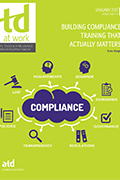The Public Manager Magazine Article
Compliance Training That's More Than Checking Boxes
Mandated training can be meaningful, relevant, and engaging.
Fri Mar 10 2017

Federal laws and guidance relating to compliance stipulate that training must be effective. For example, Title IX requires "rigorous and effective" training, according to Travis Waugh's "Building Compliance Training That Actually Matters," the January bonus issue of TD at Work.
Why, then, do far too many leaders, managers, and employees treat compliance training as an infringement on their closely shielded time, rather than as a valuable means to change behaviors around critical matters such as safety, data security, harassment, and discrimination?
Waugh—an instructional technologist for the Georgia Institute of Technology—reminds managers and trainers alike that compliance training can be relevant and engaging. He explains how instructional designers can modify their training to capture the attention of learners and help them retain important compliance information, changing their behavior.
Using the ADDIE model of instructional design, Waugh encourages instructional designers to get to the root of what the law and other regulations mandate what must be taught. This can be a challenge, as Waugh illustrates in his story of a subject matter expert who claimed "we had no choice but to include 77 text-heavy slides in an annual compliance tutorial." In reality, the law mandated only that employees receive annual training in the area but did not stipulate what the training must include.
The issue of TD at Work also emphasizes that compliance training should address problems and challenges that actually exist. To determine that, Waugh suggests instructional designers "get out and talk with our learners to determine where they are and what they need, just as we would for any other learning project where we hope to achieve real results."
In determining what content to include in training, Waugh encourages instructional designers to meet the SMARTER criteria: material that is specific, measurable, achievable, relevant, traceable, efficient, and reviewable. For example, use a story or explain how a point will be relevant to the audience—and don't use training that involves a scenario that takes place in a factory if your employees work in an office.
Waugh also advises designers to be considerate of employees' schedules by using the least amount of time and fewest words possible to convey learning points. Employees and managers will appreciate it, even if they don't actually utter the words "thank you."
Learners will also take a cue from how the training is packaged. Who wants to spend time on a course titled "FERQ Mandatory Compliance Training Initiative 2016/17"? If training is conducted online, make sure the lessons are attractively packaged, Waugh writes. Focusing on the learning that will take place and its relevance to the employee, rather than the applicable law, will make the training more palatable.
For both private and public sector employees and managers, attention to compliance helps ensure an environment free from bullying, maintain data—such as citizen Social Security numbers—in a secure fashion, and abide by appropriate hiring and retention practices. Waugh's guidance can make training more enjoyable and effective at meeting these goals.
